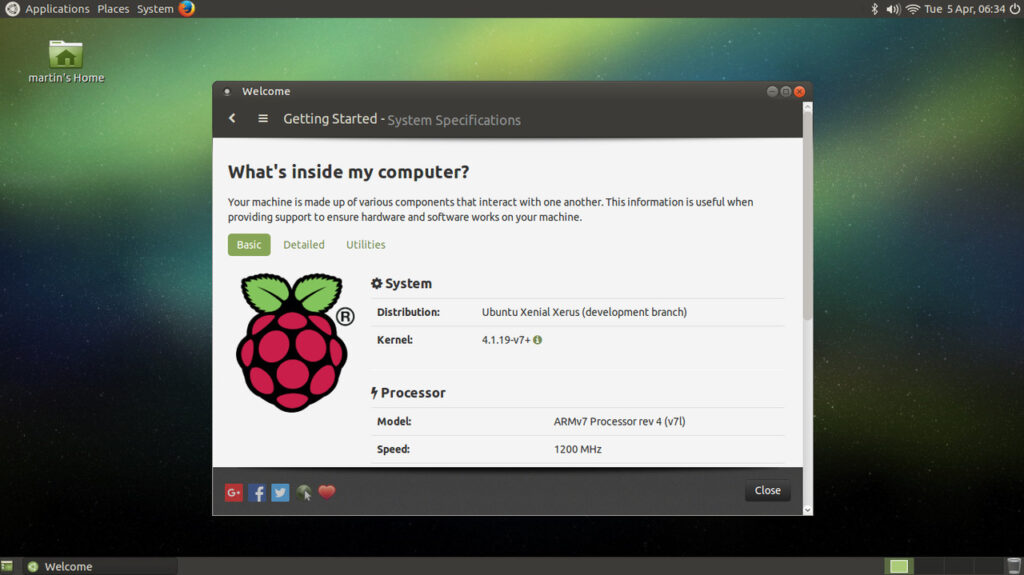Table of Contents
Introduction

The Raspberry Pi, a small yet powerful single-board computer, has captured the hearts of tech enthusiasts and developers around the world. Whether you’re a hobbyist, a student, or a professional, the Raspberry Pi offers a versatile platform for various projects. But to unleash its full potential, you need the right development environment.
In this comprehensive guide, we’ll explore the different development environments available for the Raspberry Pi. From beginner-friendly options to advanced setups, we’ll cover it all. Plus, along the way, we’ll integrate links to some of our related blog articles that can provide you with more in-depth information on specific topics.
Part 1: Setting Up Raspberry Pi OS

One of the most accessible ways to get started with your Raspberry Pi is to use Raspberry Pi OS, formerly known as Raspbian. This official operating system comes pre-installed with essential tools for coding and project development.
Raspberry Pi OS comes in several versions, each tailored to different needs:
- Raspberry Pi OS (Lite): This is a minimal version of the OS that doesn’t include a graphical desktop environment. It’s ideal for headless projects or when you want to conserve system resources.
- Raspberry Pi OS (with Desktop): This version includes the PIXEL desktop environment, making it suitable for general-purpose use and development with a graphical interface.
- Raspberry Pi OS (Full): This is the complete package, including various software and applications for a comprehensive computing experience.
Installation Process
Setting up Raspberry Pi OS is a straightforward process. You can download the desired version from the official Raspberry Pi website and flash it onto a microSD card using a tool like Etcher. Once the card is prepared, insert it into your Raspberry Pi, power it on, and follow the on-screen setup instructions.
Development Tools Included
Raspberry Pi OS comes pre-loaded with a variety of development tools, making it easy to get started with coding and project development. Some of the tools and programming languages included are:
- Thonny: A beginner-friendly Python IDE that simplifies Python programming.
- IDLE: Another Python IDE that’s part of the standard Python distribution.
- Geany: A lightweight and versatile text editor with syntax highlighting for various programming languages.
- Scratch: A visual programming language for beginners, perfect for teaching kids and newcomers to coding.
- Sonic Pi: A fun and creative way to learn programming through music composition.
- Node-RED: A flow-based development tool for visual programming and IoT projects.
- BlueJ: An integrated development environment for Java, ideal for educational purposes.
- Arduino IDE: If you’re interested in working with Arduino in addition to Raspberry Pi, the Arduino IDE is included.
Updating and Customizing
After the initial setup, it’s essential to keep your Raspberry Pi OS up-to-date. You can do this by opening a terminal window and running the following commands:
sudo apt update
sudo apt upgradeAdditionally, you can customize your environment by installing additional packages and software tailored to your specific project needs. Raspberry Pi OS’s package manager, APT (Advanced Package Tool), makes it easy to install new software and libraries.
Part 2: Python Programming on Raspberry Pi
Python is the preferred language for many Raspberry Pi enthusiasts due to its simplicity and readability. It’s an excellent choice for beginners and experienced developers alike. With Python on your Raspberry Pi, you can easily get started with coding and project development.
Why Python on Raspberry Pi?
Python is a popular programming language known for its simplicity and readability. It’s an excellent choice for Raspberry Pi development due to its ease of use, extensive libraries, and a supportive community. Whether you’re a beginner or an experienced developer, Python offers a robust platform for creating a wide range of projects on your Raspberry Pi.
Setting Up Python on Raspberry Pi
Raspberry Pi OS comes with Python pre-installed, which means you can start coding right away. However, it’s essential to ensure you have the latest version of Python and, if needed, set up virtual environments for your projects.
- Checking Python Version: Open a terminal window and enter the following command to check your Python version: python –version
If you’re using Python 2.x, consider migrating to Python 3, as Python 2 reached its end of life.
- Updating Python: To ensure you have the latest Python version, run the following commands: sudo apt update sudo apt upgrade python3
- Setting Up Virtual Environments: Virtual environments allow you to isolate your Python projects and their dependencies. To create a virtual environment, use the following commands: sudo apt install python3-venv # Install the venv package python3 -m venv myenv # Create a virtual environment named “myenv” source myenv/bin/activate # Activate the virtual environment
Python Development Tools

Raspberry Pi OS includes various Python development tools to enhance your coding experience. Here are some notable ones:
- Thonny: Thonny is a beginner-friendly Python Integrated Development Environment (IDE) that simplifies Python programming. You can find it in the Raspberry Pi menu under “Programming.”
- IDLE: IDLE is another Python IDE included with Raspberry Pi OS. It’s part of the standard Python distribution and provides a straightforward interface for writing and running Python code.
- Geany: Geany is a lightweight text editor with syntax highlighting for multiple programming languages, including Python. It’s an excellent choice if you prefer a more minimalistic coding environment.
Python Projects on Raspberry Pi
With Python on your Raspberry Pi, the possibilities are endless. You can explore various projects, from simple scripts to complex applications. Here are some project ideas to get you started:
- LED Control: Learn how to control LEDs and other GPIO (General Purpose Input/Output) devices using Python. This project is perfect for beginners.
- Weather Station: Create a weather station that collects data from sensors and displays it on an LCD screen or sends it to a web server.
- Home Automation: Build a home automation system to control lights, appliances, and security devices using Python and IoT components.
- Web Development: Use Python to develop web applications with frameworks like Flask or Django. Raspberry Pi can serve as a web server for hosting your projects.
- Data Logging: Set up a data logging system to monitor and record sensor data, which can be analyzed later.
- Robotics: Explore robotics by programming robots or robotic arms with Python to perform various tasks.
Resources and Further Reading
To delve deeper into Python programming on the Raspberry Pi, check out our blog post Raspberry Pi vs. Arduino: Making the Right Choice. While it primarily discusses the differences between Raspberry Pi and Arduino, it offers insights into using Python for your Raspberry Pi projects.
Part 3: Web Development with Raspberry Pi

Web development on Raspberry Pi offers several advantages, including affordability, low power consumption, accessibility, and educational value. In this part, we’ll explore how to set up
a web development environment on your Raspberry Pi and create web-based projects.
Setting Up a Web Development Environment
To start your journey into web development with Raspberry Pi, follow these steps:
- Install Raspberry Pi OS: If you haven’t already, install Raspberry Pi OS on your Raspberry Pi. You can choose the version that includes the desktop environment for a more user-friendly experience.
- Web Server Software: You’ll need a web server software to host your web projects. Apache and Nginx are popular choices. You can install Apache with the following command: sudo apt install apache2
- Testing the Server: After installation, open a web browser and enter your Raspberry Pi’s IP address. You should see the default Apache page, indicating that your web server is up and running.
- Coding Your Website: Develop your website or web application using HTML, CSS, and JavaScript. You can use simple text editors like Geany or more robust integrated development environments like Thonny or Visual Studio Code.
Creating Web-Based Projects
Here are some web-based project ideas to explore on your Raspberry Pi:
- Personal Website: Build your personal website or blog using HTML, CSS, and perhaps a static site generator like Jekyll. You can use Raspberry Pi as a web host for your site.
- Remote Control Interface: Create a web interface to remotely control devices connected to your Raspberry Pi, such as LEDs, sensors, or even home automation systems.
- Data Visualization: Develop web-based data visualization dashboards using libraries like D3.js to display real-time or historical data from sensors or IoT devices.
- Weather Station Dashboard: Build a web-based dashboard that displays weather information collected by sensors connected to your Raspberry Pi.
- Web-Based Games: Explore web game development using HTML5 and JavaScript. Raspberry Pi can handle simple browser games.
- IoT Projects: Combine web development with IoT by creating web interfaces to monitor and control IoT devices and sensors.
Resources and Further Reading
To dive deeper into web development with Raspberry Pi, consider exploring our blog post Exploring Affordable Alternatives to Arduino for Beginners. While the article mainly discusses alternatives to Arduino, it provides insights into web development and how Raspberry Pi can serve as a web server for your projects.
Part 4: Conclusion
In conclusion, the Raspberry Pi offers a wide range of development possibilities, and choosing the right development environment is crucial. We’ve explored various options in this article and integrated links to our related blog posts for more in-depth information.
Whether you’re a beginner or an experienced developer, you’ll find valuable insights in our exploration of Raspberry Pi development environments. Stay tuned for more parts in this series as we continue to unlock the full potential of the Raspberry Pi.
This concludes the complete article on “What Development Environment Can I Use for the Raspberry Pi?” I hope you find this comprehensive guide helpful for your Raspberry Pi projects. If you have any further questions or need more information on specific topics, feel free to ask. Happy coding!

Leave a Reply